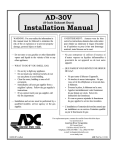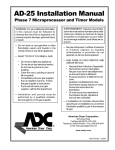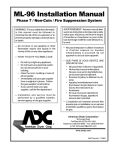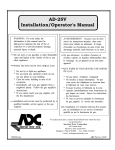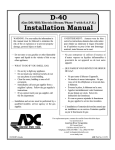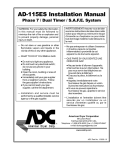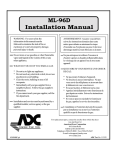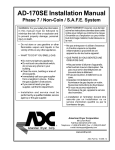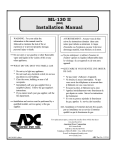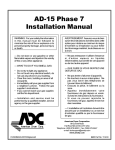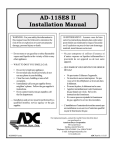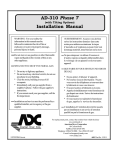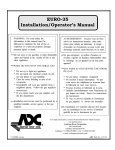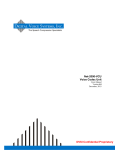Download American Dryer Corp. ADH-75 Installation manual
Transcript
ADH-75/ADH-120/ADH-170 Installation Manual HEPA NOTE: This dryer has not been scrubbed/decontaminated prior to shipping. American Dryer Corporation 88 Currant Road Fall River MA 02720-4781 USA Telephone: (508) 678-9000 / Fax: (508) 678-9447 e-mail: [email protected] www.amdry.com ADC Part No. 113247-3 Retain This Manual in a Safe Place for Future Reference This product embodies advanced concepts in engineering, design, and safety. If this product is properly maintained, it will provide many years of safe, efficient, and trouble free operation. Only qualified technicians should service this equipment. OBSERVE ALL SAFETY PRECAUTIONS displayed on the equipment or specified in the installation manual included with the dryer. The following “FOR YOUR SAFETY” caution must be posted near the dryer in a prominent location. FOR YOUR SAFETY POUR VOTRE SÉCURITÉ Do not store or use gasoline or other flammable vapors and liquids in the vicinity of this or any other appliance. Ne pas entreposer ni utiliser d’essence ni d’autres vapeurs ou liquides inflammables à proximité de cet appareil ou de tout autre appareil. We have tried to make this manual as complete as possible and hope you will find it useful. The manufacturer reserves the right to make changes from time to time, without notice or obligation, in prices, specifications, colors, and material, and to change or discontinue models. The illustrations included in this manual may not depict your particular dryer exactly. IMPORTANT For your convenience, log the following information: DATE OF PURCHASE ___________________________________________________ MODEL NO. ________________________ RESELLER’S NAME _______________________________________________________________________________________ Serial Number(s) _________________________________________________________________________________________ _______________________________________________________________________________________________________ _______________________________________________________________________________________________________ Replacement parts can be obtained from your reseller or the ADC factory. When ordering replacement parts from the factory, you can FAX your order to ADC at (508) 678-9447 or telephone your order directly to the ADC Parts Department at (508) 678-9000. Please specify the dryer model number and serial number in addition to the description and part number, so that your order is processed accurately and promptly. “IMPORTANT NOTE TO PURCHASER” Information must be obtained from your local gas supplier on the instructions to be followed if the user smells gas. These instructions must be posted in a prominent location near the dryer. IMPORTANT You must disconnect and lockout the electric supply and the gas supply or the steam supply before any covers or guards are removed from the machine to allow access for cleaning, adjusting, installation, or testing of any equipment per OSHA standards. Please observe all safety precautions displayed on the equipment and/or specified in the installation manual included with the dryer. CAUTION Dryer(s) should never be left unattended while in operation. “Caution: Label all wires prior to disconnection when servicing controls. Wiring errors can cause improper operation.” «Attention: Lor des opérations d’entretien des commandes étiqueter tous filsnt de les déconnecter. Toute erreur de câblage peut étre une source de danger et de panne.» WARNING Children should not be allowed to play on or near the dryer(s). Children should be supervised if near dryer(s) in operation. Table of Contents _______ Safety Precautions .................................... 4 Specifications ............................................ 5 Installation Procedures ........................... 16 Location Requirements ................................................. 16 Unpacking/Setting Up ................................................... 16 Dryer Enclosure Requirements .................................... 17 Fresh Air Supply Requirements .................................... 17 Exhaust Requirements ................................................. 18 Electrical Information .................................................... 21 Steam Information ......................................................... 25 Filter Information ............................................................ 28 Preparation for Operation/Start-Up ............................... 29 Preoperational Test ....................................................... 29 Preoperational Instructions ........................................... 30 Shutdown Instructions .................................................. 30 Service/Parts Information ....................... 31 Service ........................................................................... 31 Parts .............................................................................. 31 Warranty Information .............................. 31 Returning Warranty Cards ............................................ 31 Warranty ........................................................................ 31 Returning Warranty Parts ............................................. 31 Routine Maintenance ............................... 32 Cleaning ......................................................................... 32 Adjustments .................................................................. 32 Lubrication ..................................................................... 32 Procedure for Functional Check of Replacement Components .................. 33 Data Label Information ............................ 33 Under no circumstances should the dryer door switch(es), lint door/drawer switch(es), or heat safety circuit(s) ever be disabled. Manual Reset Burner Hi-Limit Instructions ................... 34 The dryer must never be operated with any of the back guards, outer tops, or service panels removed. Personal injury or fire could result. High Temperature Alarm ......................... 34 The dryer must never be operated without the lint filter/screen in place, even if an external lint collection system is used. FOR YOUR SAFETY Do not dry mop heads in the dryer. Do not use dryer in the presence of dry cleaning fumes. The dryers must not be installed or stored in an area where it will be exposed to water and/or weather. The wiring diagram for the dryer is located in the front electrical control box area. Mechanical Timer .......................................................... 34 Door Interlock .......................................... 34 List of Acronyms ______________________ CCW CW D.M.S. DSI HEPA HVAC in WC L.C.D. L.E.D. L.P. OSHA R.M.A. – – – – – – – – – – – – Counterclockwise Clockwise Drill Measurement Size Direct Spark Ignition High Efficiency Particle Accumulator Heating, Ventilating, and Air-Conditioning Inch of Water Column Liquid Crystal Display Light Emitting Diode Liquid Propane Occupational Safety and Health Administration Return Material Authorization Safety Precautions ____________________ Warning ! For your safety, the information in this manual must be followed to minimize the risk of fire or explosion or to prevent property damage, personal injury, or loss of life. The dryer must never be operated with any of the back guards, outer tops, or service panels removed. Personal injury or fire could result. Do not store or use gasoline or other flammable vapors and liquids in the vicinity of this or any other appliance. Purchaser and user should consult the local gas supplier for proper instructions to be followed in the event the user smells gas. The instructions should be posted in a prominent location. What To Do If You Smell Gas: For personal safety, the dryer must be electrically grounded in accordance with local codes and/or the National Electrical Code ANSI/NFPA NO. 70-LATEST EDITION or in Canada, the Canadian Electrical Codes Parts 1 & 2 CSA C22.1-1990 or LATEST EDITION. Note ! Failure to electrically ground the dryer properly will void the warranty. Under no circumstances should the dryer door switch(es), lint door/drawer switch(es), or heat safety circuit(s) ever be disabled. Warning ! Personal injury or fire could result should the dryer door switch, lint door/drawer, or heat safety circuit ever be disabled. This dryer is not to be used in the presence of dry cleaning solvents or fumes. • Do not try to light any appliance. Remove articles from the dryer as soon as the drying cycle has been completed. • Do not touch any electrical switch. • Do not use any phone in your building. Warning • Clear the room, building, or area of all occupants. • Immediately call your gas supplier from a neighbor’s phone. Follow the gas supplier’s instructions. ! Articles left in the dryer after the drying and cooling cycles have been completed can create a fire hazard. • If you cannot reach your gas supplier, call the fire department. Installation and service must be performed by a qualified installer, service agency, or gas supplier. Dryers must be exhausted to the outdoors. Although the manufacturer produces a very versatile dryer, there are some articles that, due to fabric composition or cleaning method, should not be dried in it. Warning ! Dry only water washed fabrics. Do not dry articles spotted or washed in dry cleaning solvents, a combustible detergent, or “all purpose” cleaner. Explosion could result. Do not dry rags or articles coated or contaminated with gasoline, kerosene, oil, paint, or wax. Explosion could result. Do not dry mop heads. Contamination by wax or flammable solvents will create a fire hazard. Do not use heat for drying articles that contain plastic, foam, sponge rubber, or similarly textured rubber materials. Drying in a heated tumbler may damage plastics or rubber and also may be a fire hazard. A program should be established for the inspection and cleaning of lint in the burner area, exhaust ductwork, and area around the back of the dryer. The frequency of inspection and cleaning can best be determined from experience at each location. Do not operate steam dryers with more than 125 psi (8.62 bar) steam pressure. Excessive steam pressure can damage steam coil and/or harm personnel. Replace leaking flexible hoses or other steam fixtures immediately. Do not operate the dryer with leaking flexible hoses. Personal injury may result. Read and follow all caution and direction labels attached to the dryer. For safety, proper operation, and optimum performance, the dryer must not be operated with a load less than sixty-six percent (66%) of its rated capacity. Warning ! You must disconnect and lockout the electric supply and the gas supply or the steam supply before any covers or guards are removed from the machine to allow access for cleaning, adjusting, installation, or testing of any equipment per OSHA standards. Important ! The dryer must be installed in a location/ environment, which the ambient temperature remains between 40° F (4.44° C) and 130° F (54.44° C). Warning ! The collection of lint in the burner area and exhaust ductwork can create a potential fire hazard. 4 American Dryer Corp. 113247 - 3 ADH-75 Specifications ______________________________________________ Steam 34.02 kg 93.98 cm 91.44 cm 634.30 L 0.75 kW N /A 54.61 cm N /A 75 lb 37” 36” 22.4 cu ft 1 hp N/A 21-1/2” N/A 208-460v 721 lb 771 lb 1,200 cfm 10” N/A 10 / 20 24 / 26 1, 3ø w 50/60 Hz 327.04 kg 349.72 kg 33.98 cmm 25.40 cm 1/8” N.P.T. 0.02 cmh 0.75 cfh Electric MAXIMUM CAPACITY (DRY WEIGHT) TUMBLER DIAMETER TUMBLER DEPTH TUMBLER VOLUME TUMBLER/DRIVE MOTOR BLOWER/FAN MOTOR DOOR OPENING (DIAMETER) DOOR SILL HEIGHT WATER CONNECTION DRYERS PER 20’/40’ CONTAINER DRYERS PER 48’/53’ TRUCK VOLTAGE AVAILABLE APPROX. NET WEIGHT APPROX. SHIPPING WEIGHT AIRFLOW EXHAUST CONNECTION (DIAMETER) COMPRESSED AIR CONNECTION COMPRESSED AIR VOLUME OVEN SIZE kcal/hr kW Btu/hr 17,200 20 68,200 20,600 24 81,900 25,800 30 102,400 28,400 33 112,600 31,000 36 122,800 34,400 40 136,500 VOLTAGE AVAILABLE APPROX. NET WEIGHT APPROX. SHIPPING WEIGHT AIRFLOW STEAM CONSUMPTION OPERATING STEAM PRESSURE EXHAUST CONNECTION (DIAMETER) COMPRESSED AIR CONNECTION COMPRESSED AIR VOLUME BOILER HP (NORMAL LOAD) SUPPLY CONNECTION RETURN CONNECTION 120-460v 1, 3ø w 50/60 Hz 343.37 kg 757 lb 366.05 kg 807 lb 38.23 cmm 1,350 cfm 108.27 kg/hr 238.7 lb/hr 8.62 bar 125 psi max 25.40 cm 10” 1/8” F.N.P.T. 0.02 cmh 0.75 cfh 7 1” F.N.P.T. 1” F.N.P.T. Shaded areas are stated in metric equivalents ! Note The manufacturer reserves the right to make changes in specifications at any time without notice or obligation. 113247 - 3 www.amdry.com 5 ADEH-75 HEPA Filter Dryer __________________________________________ 6 American Dryer Corp. 113247 - 3 ADH-120 Specifications _____________________________________________ N/ A 3 / 7 9 / 9 Electric Steam N/ A 208-600v 3ø 3,4w 50/60 Hz 738.90 kg 1,629 lb 795.60 kg 1,754 lb 60.88 cmm 2,150 cfm 40.64 cm 16” 1/8” N.P.T. N/A 208-575v 3ø 3,4w 50/60 Hz 811.93 kg 1,790 lb 868.63 kg 1,915 lb 55.22 cmm 1,950 cfm 204.12 kg/hr 450 lb/hr 8.62 bar 125 psi max 40.64 cm 16” 1/8” N.P.T. 0.09 cmh 3.25 cfh 13 Bhp (2) 1” F.N.P.T. (2) 1/2” F.N.P.T. Shaded areas are stated in metric equivalents ! 54.43 kg 113.03 cm 107.95 cm 1,081.70 L 0.56 kW 2.24 kW 79.69 cm 66.68 cm 120 lb 44-1/2” 42-1/2” 38.20 cu ft 3/4 hp 3 hp 31-3/8” 26-1/4” Gas MAXIMUM CAPACITY (DRY WEIGHT) TUMBLER DIAMETER TUMBLER DEPTH TUMBLER VOLUME TUMBLER/DRIVE MOTOR BLOWER/FAN MOTOR DOOR OPENING (DIAMETER) DOOR SILL HEIGHT WATER CONNECTION DRYERS PER 20’/40’ CONTAINER DRYERS PER 48’/53’ TRUCK VOLTAGE AVAILABLE APPROXIMATE NET WEIGHT APPROXIMATE SHIPPING WEIGHT AIRFLOW HEAT INPUT EXHAUST CONNECTION (DIAMETER) COMPRESSED AIR CONNECTION COMPRESSED AIR VOLUME INLET PIPE CONNECTION VOLTAGE AVAILABLE APPROXIMATE NET WEIGHT APPROXIMATE SHIPPING WEIGHT AIRFLOW EXHAUST CONNECTION (DIAMETER) COMPRESSED AIR CONNECTION COMPRESSED AIR VOLUME OVEN SIZE kcal/hr kW Btu/hr 51,608 60 204,780 61,900 72 245,700 VOLTAGE AVAILABLE APPROXIMATE NET WEIGHT APPROXIMATE SHIPPING WEIGHT AIRFLOW STEAM CONSUMPTION OPERATING STEAM PRESSURE EXHAUST CONNECTION (DIAMETER) COMPRESSED AIR CONNECTION COMPRESSED AIR VOLUME BOILER HORSEPOWER (NORMAL LOAD) SUPPLY CONNECTION RETURN CONNECTION September 2004 Note The manufacturer reserves the right to make changes in specifications at any time without notice or obligation. 113247 - 3 www.amdry.com 7 ADEH-120 HEPA Filter Dryer 8 _________________________________________________________ American Dryer Corp. 113247 - 3 ADSH-120 HEPA Filter Dryer _________________________________________________________ 113247 - 3 www.amdry.com 9 ADSH-120 Component Identification Front View ____________________ Illus. No. 1 2 3 4 5 6 7 8 9 10 11 10 Description Microprocessor Control/Keypad Panel Assembly (Controls) Control (Top Access) Door Assembly Main Door Assembly Lint Chamber Access Panel Lint Screen Wire Diagram (Located Behind Control Door) Filter Housing Assembly Steam Damper Assembly Lint Door Differential Pressure Gauge and High Temp Alarm Panel Door Interlock American Dryer Corp. 113247 - 3 ADSH-120 Component Identification Rear View _____________________ Illus. No. 1 2 3 4 5 6* 7 8 9 Description Basket (Drive) Motor Assembly Blower Motor Mount Assembly Impellor (Fan/Blower) Assembly Idler Bearing Mount Assembly Tumbler Bearing Mount Assembly Electric Service Relay Box Filter Housing Steam Coil Filter Access Panel * Electric service connections are made in this box for steam only. 113247 - 3 www.amdry.com 11 ADH-170 Specifications _____________________________________________ N N 3 8 12 / / / / A A 7 8 Electric N / A Steam N / A 208-575v 3ø 3,4w 50/60 Hz 929.86 kg 2,050 lb 1,006.98 kg 2,220 lb 124.59 cmm 4,400 cfm 328.85 kg/hr 725 lb/hr 8.62 bar 125 psi max 45.72 cm 18” 1/8” F.N.P.T. 5.52 bar 80 psi 0.09 cmm 3.25 cfh 19 Bhp 1-1/2” F.N.P.T. 1-1/2” F.N.P.T. Shaded areas are stated in metric equivalents ! 77.11 kg 130.81 cm 107.95 cm 1,449.82 L 0.75 kW 5.59 kW 79.69 cm 170 lb 51-1/2” 42-1/2” 51.20 cu ft 1 hp 7-1/2 hp 31-3/8” Gas MAXIMUM CAPACITY (DRY WEIGHT) TUMBLER DIAMETER TUMBLER DEPTH TUMBLER VOLUME TUMBLER/DRIVE MOTOR BLOWER/FAN MOTOR DOOR OPENING (DIAMETER) DOOR SILL HEIGHT WATER CONNECTION DRYERS PER 20’/40’ CONTAINER DRYERS PER 48’/53’ TRUCK VOLTAGE AVAILABLE APPROXIMATE NET WEIGHT APPROXIMATE SHIPPING WEIGHT AIRFLOW HEAT INPUT EXHAUST CONNECTION (DIAMETER) COMPRESSED AIR CONNECTION COMPRESSED AIR VOLUME INLET PIPE CONNECTION VOLTAGE AVAILABLE APPROXIMATE NET WEIGHT APPROXIMATE SHIPPING WEIGHT AIRFLOW EXHAUST CONNECTION (DIAMETER) COMPRESSED AIR CONNECTION COMPRESSED AIR VOLUME OVEN SIZE kcal/hr kW Btu/hr VOLTAGE AVAILABLE APPROXIMATE NET WEIGHT APPROXIMATE SHIPPING WEIGHT AIRFLOW STEAM CONSUMPTION OPERATING STEAM PRESSURE EXHAUST CONNECTION (DIAMETER) COMPRESSED AIR CONNECTION COMPRESSED AIR REQUIREMENT COMPRESSED AIR VOLUME BOILER HORSEPOWER (NORMAL LOAD) SUPPLY CONNECTION RETURN CONNECTION September 2004 Note The manufacturer reserves the right to make changes in specifications at any time without notice or obligation. American Dryer Corp. 113247 - 3 ADSH-170 HEPA Filter Dryer _________________________________________ 113247 - 3 www.amdry.com 13 ADSH-170 Component Identification Front View ____________________ Illus. No. 1 2 3 4 5 6 7 8 9 10 11 12 13 14 Description Microprocessor Control/Keypad Panel Assembly (Controls) Control (Top Access) Door Assembly Main Door Assembly Lint Door Assembly Lint Chamber Access Panel Wire Diagram Top Console (Module) Assembly Data Label and Installation Label Door Interlock Lint Screen Differential Pressure/High Temp Alarm Panel Filter Housing Steam Damper Assembly (illustrated; electric oven would be located in the same area) American Dryer Corp. 113247 - 3 ADSH-170 Component Identification Rear View _____________________ Illus. No. 1 2 3 4 5* 6 7 8 9 10 11 * Description Basket (Drive) Motor Assembly Blower Motor Mount Assembly Idler Bearing Mount Assembly Tumbler Bearing Mount Assembly Electric Service Relay Box Steam Damper Filter Access Panel 1/8” Compressed Air Supply Inlet (Behind Gusset) Side Access Opening Front Access Opening Impellor (Fan) Assembly Electric service connections are made in this box for steam only. 113247 - 3 www.amdry.com 15 Installation Procedures _______________ Important ! Installation should be performed by competent technicians in accordance with local and state codes. In the absence of these codes, the installation must conform to applicable American National Standards: ANSI Z223.1-LATEST EDITION (National Fuel Gas Code) or ANSI/NFPA NO. 70-LATEST EDITION (National Electrical Code) or in Canada, the installation must conform to applicable Canadian Standards: CAN/CGA-B149.1-M91 (Natural Gas) or CAN/CGA-B149.2M91 (L.P. Gas) or LATEST EDITION (for General Installation and Gas Plumbing) or Canadian Electrical Codes Parts 1 & 2 CSA C22.1-1990 or LATEST EDITION (for Electrical Connections). The dryer must be installed in a location/ environment, which the ambient temperature remains between 40° F (4.44° C) and 130° F (54.44° C). Location Requirements _______________ The dryer can be moved to its final location while still attached to the skid or with the skid removed. To remove the skid from the dryer, locate and remove the 4 bolts securing the base of the dryer to the wooden skid. 2 are at the rear base (remove the back panel for access) and 2 are located in the bottom of the lint chamber. (Remove the lint drawer/door for access.) Before installing the dryer, be sure the location conforms to local codes and ordinances. In the absence of such codes or ordinances the location must conform with the National Fuel Gas Code ANSI.Z223.1 LATEST EDITION, or in Canada, the installation must conform to applicable Canadian Standards: CAN/CGA-B149.1-M91 (Natural Gas) or CAN/CGA-B149.2-M91 (L.P. Gas) or LATEST EDITION (for General Installation and Gas Plumbing). The dryer must be installed on a sound level floor capable of supporting its weight. Carpeting must be removed from the floor area that the dryer is to rest on. Important ! “The dryer must be installed on noncombustible floors only.” The dryer must not be installed or stored in an area where it will be exposed to water and/or weather. The dryer is for use in noncombustible locations. Provisions for adequate air supply must be provided as noted in this manual (refer to Fresh Air Supply Requirements section). Unpacking/Setting Up _________________ Remove protective shipping material (i.e., plastic wrap and optional shipping box) from the dryer. Important ! Dryer must be transported and handled in an upright position at all times. Leveling Dryer – ADH-75 With the skid removed, to make it easier to slide the dryer into its final position, slightly lower all 4 leveling legs, so that the dryer will slide on the legs instead of the base frame. The dryer is equipped with 4 leveling legs, 1 at each corner of the base. 2 are located at the rear of the dryer base, and 2 are located in the lint chamber. To increase bearing life and improve efficiency, the dryer should be tilted slightly to the rear. Leveling Dryer – ADH-120 and ADH-170 To level dryer, place 4-inch (10.16 cm) square metal shims (refer to the illustration below) or other suitable material under the base pads. It is suggested that the dryer be tilted slightly to the rear. Clearance provisions must be made from combustible construction as noted in this manual (refer to Dryer Enclosure Requirements section). Provisions must be made for adequate clearances for servicing and for operation as noted in this manual (refer to Dryer Enclosure Requirements section). The dryer must be installed with a proper exhaust duct connection to the outside as noted in this manual (refer to Exhaust Requirements section). The dryer must be located in an area where correct exhaust venting can be achieved as noted in this manual (refer to Exhaust Requirements section). Important ! The dryer should be located where a minimum amount of exhaust ducting will be necessary. The dryer must be installed with adequate clearance for air openings into the combustion chamber. Caution ! This dryer produces combustible lint and must be exhausted to the outdoors. Every 6 months, inspect the exhaust ducting and remove any lint buildup. 16 American Dryer Corp. 113247 - 3 Dryer Enclosure Requirements _______ Fresh Air Supply Requirements _______ Bulkheads and partitions should be made of noncombustible material. When the dryer is operating, it draws in room air, heats it, passes this air through the tumbler, and exhausts it out of the building. Therefore, the room air must be continually replenished from the outdoors. If the make-up air is inadequate, drying time and drying efficiency will be adversely affected. Ignition problems and sail switch “fluttering” problems may result, as well as premature motor failure from overheating. The dryer must be installed with provisions for adequate combustion and make-up air supply. Note ! Allowances must be made for opening the control door. Air supply (make-up air) must be given careful consideration to ensure proper performance of each dryer. As a general rule, an unrestricted air entrance from the outdoors (atmosphere) of a minimum of 1-1/2 square feet (0.14 square meters) ADH-75; 3 square feet (0.28 square meters) ADH-120; 4 square feet (0.37 square meters) ADH-170; is required for each dryer. A The optimum opening of load door is 30-inches (76.2 cm) for ADH-75; and 38-1/4” (76.2 cm) for ADH-120 and ADH-170. B The maximum thickness of the bulkhead is 4-inches (10.16 cm). For electric dryers the maximum thickness of the bulkhead is 1-inch (2.54 cm) within 3-inches (7.62 cm) from the top of the control door. C For electric dryers a minimum overhead clearance of 12-inches (30.48 cm) is required, providing no sprinkler is located above the dryer. For steam dryers or if a sprinkler is located above the dryer, 18-inches (45.72 cm) is required. D Dryer should be positioned 12-inches (30.48 cm) for ADH-75; 24-inches (60.96 cm) for ADH-120 and ADH-170, away from the nearest obstruction and 24-inches (60.96 cm) for ADH-75; 36-inches (91.44 cm) for ADH-120 and ADH-170 is recommended for ease of installation, maintenance, and service. E Flush to the opening of the control door. F Flooring should be level or below dryer cabinet for ease of removing panels during maintenance. G Dryers may be positioned sidewall to sidewall, however a 1/16” (1.5875 mm) minimum allowance must be made for the opening and closing of the control door, along with the removal of panels during maintenance. ADH-75 ADH-120 ADH-170 A = 2 ft (0.61 m) A = 2 ft (0.61 m) A = 3 ft (0.91 m) B = 18” (45.72 cm) B = 3 ft (0.91 m) B = 3 ft (0.91 m) To compensate for the use of registers or louvers used over the openings, this area must be increased by approximately thirty-three percent (33%). Make-up air openings should not be located in an area directly near where exhaust vents exit the building. It is not necessary to have a separate make-up air opening for each dryer. Common make-up air openings are acceptable. However, they must be set up in such a manner that the make-up air is distributed equally to all the dryers. ADH-120 EXAMPLE: For a bank of 4 dryers, 2 unrestricted openings measuring 2 feet by 3 feet (0.61 meters by 0.91 meters) are acceptable. Allowances must be made for remote or constricting passageways or where dryers are located at excessive altitudes or predominantly low pressure areas. Important ! Make-up air must be provided from a source free of dry cleaning solvent fumes. Make-up air that is contaminated by dry cleaning solvent fumes will result in irreparable damage to the motors and other dryer components. Note ! 113247 - 3 www.amdry.com Component failure due to dry cleaning solvent fumes will void the warranty. 17 Exhaust Requirements ________________ Exhaust ductwork should be designed and installed by a qualified professional. Improperly sized ductwork will create excessive back pressure, which results in slow drying, increased use of energy, and shutdown of the burner by the airflow (sail) switch, burner hi-limits, or lint chamber hi-limit protector thermostat. The dryer must be installed with a proper exhaust duct connection to the outside. Caution ! This dryer produces combustible lint and must be exhausted to the outdoors. Improperly sized or installed exhaust ductwork can create a potential fire hazard. The ductwork should be laid out in such a way that the ductwork travels as directly as possible to the outdoors with as few turns as possible. Single or independent dryer venting is recommended. It is suggested that the use of 90° turns be avoided; use 30° and/or 45° bends instead. The radius of the elbows should preferably be 1-1/2 times the diameter of the duct. All ductwork should be smooth inside with no projections from sheet metal screws or other obstructions, which will collect lint. When adding ducts, the duct to be added should overlap the duct to which it is to be connected. All ductwork joints must be taped to prevent moisture and lint from escaping into the building. Inspection doors should be installed at strategic points in the exhaust ductwork for periodic inspection and cleaning of lint from the ductwork. Important ! It is recommended that exhaust or booster fans not be used in the exhaust ductwork system. Exhaust back pressure measured by a manometer/ magnehelic in the exhaust duct must be no less than 0 and must not exceed 0.3 in WC (0.74 mb). Note ! When the exhaust ductwork passes through a wall, ceiling, or roof made of combustible materials, the opening must be 2-inches (5.08 cm) larger than the duct (all the way around). The duct must be centered within this opening. NOTE 1 Opening must be 2-inches (5.08 cm) larger than the duct (all the way around). The duct must be centered within this opening. NOTE 2 Distance should be 2 times the diameter of the duct to the nearest obstruction. Single Dryer Venting Important ! For extended ductwork runs, the cross section area of the ductwork can only be increased to an extent. When the ductwork approaches the maximum limits as noted in this manual, a professional HVAC firm should be consulted for proper venting information. As per the National Fuel Gas Code, “Exhaust ducts for type 2 clothes dryers shall be constructed of sheet metal or other noncombustible material. Such ducts shall be equivalent in strength and corrosion resistance to ducts made of galvanized sheet steel not less than 26 gauge (0.0195-inches [0.50 mm]) thick.” Outside Ductwork Protection To protect the outside end of the horizontal ductwork from the weather, a 90° elbow bent downward should be installed where the exhaust exits the building. If the ductwork travels vertically up through the roof, it should be protected from the weather by using a 180° turn to point the opening downward. In either case, allow at least twice the diameter of the duct between the duct opening and the nearest obstruction (refer to the diagram). Important ! 18 Do not use screens, louvers, or caps on the outside opening of the exhaust ductwork. American Dryer Corp. 113247 - 3 Horizontal Venting NOTES ______________________________________________________ When horizontal dryer venting is used, the length of the ductwork from the dryer to the outside exhaust outlet, must not exceed Dimension A (20 feet [6.096 meters]). The minimum diameter of this ductwork must be at least Dimension B (10-inches [25.4 cm] for ADH-75; 16-inches [40.64 cm] for ADH-120; 20-inches [50.8 cm] for ADH-170). Including tumbler/dryer elbow connections or elbows used for outside protection from the weather, no more than 1 elbow should be used in the exhaust duct run. If more than 1 elbow is used, the cross-sectional area of the ductwork must be increased. _____________________________________________________________ _____________________________________________________________ _____________________________________________________________ _____________________________________________________________ _____________________________________________________________ _____________________________________________________________ Vertical Venting When vertical dryer venting is used, the length of the ductwork from the dryer to the outside exhaust outlet, must not exceed Dimension C (20 feet [6.096 meters]). Dimension D (12-inches [30.48 cm] for ADH-75; 18-inches [45.72 cm] for ADH-120; 24-inches [60.96 cm] for ADH-170). Including tumbler/dryer elbow connections or elbows used for outside protection from the weather, no more than 3 elbows should be used in the exhaust duct run. If more than 3 elbows are used, the cross-sectional area of the ductwork must be increased. _____________________________________________________________ _____________________________________________________________ _____________________________________________________________ _____________________________________________________________ _____________________________________________________________ _____________________________________________________________ _____________________________________________________________ _____________________________________________________________ _____________________________________________________________ _____________________________________________________________ _____________________________________________________________ _____________________________________________________________ _____________________________________________________________ _____________________________________________________________ _____________________________________________________________ _____________________________________________________________ _____________________________________________________________ _____________________________________________________________ _____________________________________________________________ _____________________________________________________________ _____________________________________________________________ _____________________________________________________________ _____________________________________________________________ _____________________________________________________________ _____________________________________________________________ NOTE 1 Opening must be 2-inches (5.08 cm) larger than the duct (all the way around). The duct must be centered within this opening. NOTE 2 Distance should be 2 times the diameter of the duct to the nearest obstruction. 113247 - 3 _____________________________________________________________ _____________________________________________________________ www.amdry.com 19 Multiple Dryer (Common) Venting Important ! For extended ductwork runs, the cross section area of the ductwork can only be increased to an extent. When the ductwork approaches the maximum limits as noted in this manual, a professional HVAC firm should be consulted for proper venting information. If it is not feasible to provide separate exhaust ducts for each dryer, ducts from individual dryers may be channeled into a “common main duct.” The individual ducts should enter the bottom or side of the main duct at an angle not more than 45º in the direction of airflow. The main duct should be tapered, with the diameter increasing before each individual duct is added. The minimum diameter of the individual ductwork must be at least Dimension A (12-inches [30.48 cm] for the ADH-75; 18-inches [45.72 cm] for the ADH-120; 20-inches [50.8 cm] for the ADH-170). The illustration on the right shows the minimum crosssectional area for multiple dryer round or square venting. These figures must be increased if the main duct run from the last dryer to where it exhausts to the outdoors is longer than Dimension B (20 feet [6.096 meters]) or has more than 1 elbow in it. ADH-75 NOTES ______________________________________________________ Multiple Dryer Venting with 12-Inch (30.48 cm) Diameter 1,200 cfm (33.98 cmm) Exhaust Connections at Common Duct NUMBER OF DRYERS SQ IN MINIMUM CROSSSECTIONAL AREA SQ CM IN MINIMUM ROUND DUCT DIAMETER CM 4 315 2032 20 51 3 254 1638 18 46 2 200 1290 16 41 1 115 729 12 30 ADH-120 4 455 2935 24 61 3 380 2452 22 56 2 255 1645 20 51 1 115 742 18 46 ADH-75 and ADH-120: No more than 4 dryers should be connected to 1 main common duct. ADH-170 Multiple Dryer Venting with 20-Inch (50.8 cm) Diameter 4,400 cfm (124.59 cmm) Exhaust Connections at Common Duct NUMBER OF DRYERS SQ IN MINIMUM CROSSSECTIONAL AREA SQ CM IN MINIMUM ROUND DUCT DIAMETER CM 3 707 4561 30 76 2 531 3426 26 66 1 315 2032 20 51 Important ! _____________________________________________________________ _____________________________________________________________ _____________________________________________________________ _____________________________________________________________ _____________________________________________________________ _____________________________________________________________ _____________________________________________________________ Important ! _____________________________________________________________ _____________________________________________________________ Multiple Dryer Venting with 18-Inch (45.72 cm) Diameter 2,500 cfm (70.79 cmm) Exhaust Connections at Common Duct NUMBER OF DRYERS SQ IN MINIMUM CROSSSECTIONAL AREA SQ CM IN MINIMUM ROUND DUCT DIAMETER CM NOTE 1 Opening must be 2-inches (5.08 cm) larger than the duct (all the way around). The duct must be centered within this opening. NOTE 2 Distance should be 2 times the diameter of the duct to the nearest obstruction. ADH-170: No more than 3 dryers should be connected to 1 main common duct. _____________________________________________________________ _____________________________________________________________ _____________________________________________________________ _____________________________________________________________ _____________________________________________________________ _____________________________________________________________ _____________________________________________________________ _____________________________________________________________ _____________________________________________________________ _____________________________________________________________ _____________________________________________________________ 20 American Dryer Corp. 113247 - 3 Electrical Information _________________ Electrical Requirements All electrical connections must be made by a properly licensed and competent electrician. This is to ensure that the electrical installation is adequate and conforms to local and state regulations or codes. In the absence of such codes, all electrical connections, materials, and workmanship must conform to the applicable requirements of the National Electrical Code ANSI/NFPA NO. 70-LATEST EDITION or in Canada, the Canadian Electrical Codes Parts 1 & 2 CSA C22.1-1990 or LATEST EDITION. Important Electrical Service Specifications Important ! Figures shown are for reversing models only. For non-reversing models contact the factory. ADSH-75 Steam Models Only Not available at time of printing. Contact the factory. ADSH-120 Steam Models Only ELECTRICAL SERVICE SPECIFICATIONS (PER DRYER) IMPORTANT: 208 VAC AND 230/240 VAC ARE NOT THE SAME. When ordering, specify exact voltage. ! Failure to comply with these codes or ordinances, and/or the requirements stipulated in this manual can result in personal injury or component failure. NOTES: B. Note ! Component failure due to improper installation will void the warranty. Each dryer should be connected to an independently protected branch circuit. The dryer must be connected with copper wire only. Do not use aluminum wire, which could cause a fire hazard. The copper conductor wire/cable must be of proper ampacity and insulation in accordance with electric codes for making all service connections. Note ! The use of aluminum wire will void the warranty. An individual ground circuit must be provided to each dryer, do not daisy chain. Component failure due to improper voltage application will void the warranty. The manufacturer reserves the right to make changes in specifications at any time without notice or obligation. Important ! A. A separate protected circuit must be provided to each dryer. C. PHASE WIRE SERVICE 60 Hz 50 Hz 208 3ø 3 14.5 — 20 240 3ø 3 14.6 — 20 230 3ø 3 — 17.4 25 380 3ø 3 8.5 — 15 380-400 3ø 4* — 8.7 15 416 3ø 4* — 9.0 15 CIRCUIT BREAKER 440 3ø 3 8.7 — 15 460/480 3ø 3 7.8 — 15 575 3ø 3 5.8 — 15 * Customer must contact factory to special order 3-wire system. ELECTRICAL SERVICE SPECIFICATIONS (PER DRYER) IMPORTANT: 208 VAC AND 230/240 VAC ARE NOT THE SAME. When ordering, specify exact voltage. NOTES: A. B. C. When fuses are used they must be dual element, time delay, current limiting, class RK1 or RK5 ONLY. Calculate/determine correct fuse value, by applying either local and/or National Electrical Codes to listed appliance amp draw data. Circuit breakers are thermal-magnetic (industrial) motor curve type ONLY. For others, calculate/verify correct breaker size according to appliance amp draw rating and type of breaker used. Circuit breakers for 3-phase (3ø) dryers must be 3-pole type. APPROX. AMP DRAW SERVICE VOLTAGE PHASE WIRE SERVICE 60 Hz 50 Hz 208 3ø 3 28.3 — 50 240 3ø 3 26.7 — 45 230 3ø 3 — 31.9 50 380 3ø 3 16.2 — 25 380/400 3ø 4* — 16.1 25 416 3ø 4* — 16.0 25 ! CIRCUIT BREAKER 440 3ø 3 14.4 — 20 460/480 3ø 3 13.9 — 20 575 3ø 3 11.4 — 20 * Customer must contact factory to special order 3-wire system. 113247 - 3 8/15/07 ADSH-170 Steam Models Only Warning 208 VAC and 240 VAC are not the same. Any damage done to dryer components due to improper voltage connections will automatically void the warranty. APPROX. AMP DRAW SERVICE VOLTAGE The dryer must be connected to the electric supply shown on the data label. In the case of 208 VAC or 240 VAC, the supply voltage must match the electric service specifications of the data label exactly. The wire size must be properly sized to handle the related current. When fuses are used they must be dual element, time delay, current limiting, class RK1 or RK5 ONLY. Calculate/determine correct fuse value, by applying either local and/or National Electrical Codes to listed appliance amp draw data. Circuit breakers are thermal-magnetic (industrial) motor curve type ONLY. For others, calculate/verify correct breaker size according to appliance amp draw rating and type of breaker used. Circuit breakers for 3-phase (3ø) dryers must be 3-pole type. www.amdry.com 8/15/07 21 ADEH-75 Electric Models Only ADEH-120 Electric Models Only All electrically heated dryers must be connected to the electric service shown on the dryer’s data label. The connecting wires must be properly sized to handle the rated current. All electrically heated dryers must be connected to the electric service shown on the dryer’s data label. The connecting wires must be properly sized to handle the rated current. ELECTRICAL SERVICE SPECIFICATIONS (PER DRYER) ELECTRICAL SERVICE SPECIFICATIONS (PER DRYER) IMPORTANT: 208 VAC AND 230/240 VAC ARE NOT THE SAME. When ordering, specify exact voltage. IMPORTANT: 208 VAC AND 230/240 VAC ARE NOT THE SAME. When ordering, specify exact voltage. NOTES: NOTES: A. B. C. SERVICE VOLTAGE When fuses are used they must be dual element, time delay, current limiting, class RK1 or RK5 ONLY. Calculate/determine correct fuse value, by applying either local and/or National Electrical Codes to listed appliance amp draw data. Circuit breakers are thermal-magnetic (industrial) type ONLY. For others, calculate/verify correct breaker size according to appliance amp draw rating and type of breaker used. Circuit breakers for 3-phase (3ø) dryers must be 3-pole type. PHASE WIRE SERVICE APPROX. AMP DRAW 60 Hz 50 Hz CIRCUIT BREAKER A. B. C. SERVICE VOLTAGE When fuses are used they must be dual element, time delay, current limiting, class RK1 or RK5 ONLY. Calculate/determine correct fuse value, by applying either local and/or National Electrical Codes to listed appliance amp draw data. Circuit breakers are thermal-magnetic (industrial) type ONLY. For others, calculate/verify correct breaker size according to appliance amp draw rating and type of breaker used. Circuit breakers for 3-phase (3ø) dryers must be 3-pole type. PHASE WIRE SERVICE APPROX. AMP DRAW 60 Hz 50 Hz CIRCUIT BREAKER 60 kW 30 kW 208 3ø 3 91 — 125 380 3ø 4* — 100 125 230 3ø 3 — 83 125 416 3ø 4* — 91 125 240 3ø 3 79 — 100 480 3ø 3 80 — 100 380 3ø 3 48 — 60 600 3ø 3 64 — 80 380 3ø 4* — 54 70 400 3ø 4* — 51 70 208 3ø 3 214 — 300 416 3ø 4* — 50 70 240 3ø 3 188 — 250 460 3ø 3 40 — 50 230 3ø 3 — 198 250 480 3ø 3 39 — 50 380 3ø 3 118 — 150 575 3ø 3 33 — 50 380 3ø 4* — 118 150 400 3ø 4* — 113 150 150 416 3ø 4* — 108 150 36 kW 108 — 72 kW 208 3ø 3 230 3ø 3 — 98 125 460 3ø 3 98 — 125 240 3ø 3 94 — 125 480 3ø 3 94 — 125 380 3ø 3 58 — 80 575 3ø 3 78 — 100 380 3ø 4* — 63 80 400 3ø 4* — 60 80 102 — 150 416 3ø 4* — 58 80 460 3ø 3 48 — 60 480 3ø 3 46 — 60 * Customer must contact factory to special order 3-wire systems. 8/15/07 75.6 kW 440 3ø 3 * Customer must contact factory to special order 3-wire systems. 8/15/07 ADEH-170 Electric Models Only Available upon request. Contact the factory. Grounding A ground (earth) connection must be provided and installed in accordance with state and local codes. In the absence of these codes, grounding must conform to applicable requirements of the National Electrical Code ANSI/NFPA NO. 70-LATEST EDITION, or in Canada, the installation must conform to applicable Canada Standards: Canadian Electrical Codes Parts 1 & 2 CSA C22.1-1990 or LATEST EDITION. The ground connection may be to a proven earth ground at the location service panel. 22 American Dryer Corp. 113247 - 3 For added personal safety, when possible, it is suggested that a separate ground wire (size per local codes) be connected from the ground connection of the dryer to a grounded cold water pipe. Do not ground to a gas pipe or hot water pipe. The grounded cold water pipe must have metal-to-metal connection all the way to the electrical ground. If there are any nonmetallic interruptions, such as, a meter, pump, plastic, rubber, or other insulating connectors, they must be jumped out with a wire (size per local codes) and securely clamped to bare metal at both ends. Important ! For personal safety and proper operation, the dryer must be grounded. Provisions are made for ground connection in each dryer at the electrical service connection area. Electrical Connections A wiring diagram is located inside the control box for connection data. If local codes permit, power to the dryer can be made by the use of a flexible U.L. listed power cord/pigtail (wire size must conform to rating of dryer), or the dryer can be hard wired directly to the service breaker panel. In both cases, a strain relief must be installed where the wiring enters the dryer. Single-Phase Electrical Lead Connections Black + Positive Steam Models Only Important ! White or Red + Neutral or L2 Green + Ground A separate protected circuit must be provided to each dryer. For 110V Applications Single-Phase (1ø) – ADSH-75 Only Wiring Connections/Hookup The electrical input connections on all single-phase (1ø) steam dryers are made into the rear service box located at the upper left area of the dryer. The ground connection is made to the copper lug, also provided in this box. To gain access, the service box cover must be removed. A ground lug is provided in the rear electrical box to connect your service ground. 113247 - 3 www.amdry.com 23 For 208-240V Applications Electrically Heated Models Only The electrical input connections are made at the electric oven contactor located inside the assembly at the rear center upper section of the dryer. The ground connection is made to a copper lug also provided in this area. To gain access, remove oven rear service cover. The only electrical input connections to the dryer are the 3-phase (3ø) power leads (L1, L2, L3, and sometimes neutral) and ground. Single-phase (1ø) power for the control circuit and for any single-phase (1ø) motors (if present) is done internally to the dryer by the factory at the oven contactor. No single-phase (1ø) input connection is required on a 3-phase (3ø) dryer. Caution 3-Phase (3ø) Wiring Connections/Hookup The electrical connections on all 3-phase (3ø) steam dryers are made into the rear service box located at the upper left area of the dryer. The ground connection is made to the copper lug, also provided in this box. To gain access, the service box cover must be removed. The neutral will only be used on 4-wire service. This is typical for 380-416V, 50 Hz. 24 ! The dryer must be grounded. A ground lug has been provided for this purpose. Input connection wiring must be sized properly to handle the dryer’s current draw. This information is printed on the dryer’s data label. Important ! American Dryer Corp. A strain relief must be used where the input wiring enters the oven assembly. 113247 - 3 NOTES ______________________________________________________ _____________________________________________________________ _____________________________________________________________ _____________________________________________________________ _____________________________________________________________ _____________________________________________________________ _____________________________________________________________ _____________________________________________________________ _____________________________________________________________ _____________________________________________________________ Steam Information ____________________ It is your responsibility to have all plumbing connections made by a qualified professional to ensure that the steam plumbing installation is adequate and conforms with local and state regulations or codes. Care must be exercised when leveling steam dryers into final position. After leveling the dryer, check the downward pitch of the heat exchanger from front to rear with a level. Likewise, check the downward pitch of the return condensate manifold toward its outlet part. Absence of these downward pitches will result in probable water hammer and premature heat exchanger fracture and leakage. The presence of condensate in the steam will cause water hammer and subsequent heat exchanger failure. The steam supply connection must be taken from the top of a well-dripped steam main. If the supply run-out to the dryer exceeds 20 feet (6.096 meters), it should be dripped just before the control valve with a proper trap and dirt pocket. Important _____________________________________________________________ _____________________________________________________________ _____________________________________________________________ _____________________________________________________________ ! Failure to comply with the requirements stipulated in this manual can result in component failure, which will void the warranty. Note ! _____________________________________________________________ The dryer is manufactured with a pneumatic (piston) damper system, which requires an external air supply of 6 cfh @ 80 psi +/- 10 psi (0.17 cmh @ 5.51 bar +/- 0.69 bar). _____________________________________________________________ Steam Coil pH Level _____________________________________________________________ _____________________________________________________________ _____________________________________________________________ _____________________________________________________________ _____________________________________________________________ _____________________________________________________________ _____________________________________________________________ The normal pH level for copper type steam coils must be maintained between a value of 8.5 to 9.5. For steel type steam coils the pH level must be maintained between a value of 9.5 to 10.5. These limits are set to limit the acid attack of the steam coils. Important ! Coil failure due to improper pH level will void the warranty. Steam Requirements – High Pressure ADH-75 _____________________________________________________________ Inlet ------- 1” N.P.T. supply line connection (1 at top manifold). Return --- 1” N.P.T. return line connection (1 at bottom manifold). _____________________________________________________________ OPERATING STEAM PRESSURE _____________________________________________________________ Maximum _____________________________________________________________ Heat Input (Normal Load) _____________________________________________________________ Consumption (Approximate) @ 125 psi (8.6 bar) 862 kPa 125 psig* 7 Bhp 238.7 lb/hr 108.3 kg/hr _____________________________________________________________ Shaded areas are stated in metric equivalents _____________________________________________________________ * The minimum operating pressure for optimum results is 100 psig (689.47 kPa). _____________________________________________________________ _____________________________________________________________ _____________________________________________________________ _____________________________________________________________ 113247 - 3 www.amdry.com 25 ADH-120 Inlet ------- 1” N.P.T. supply line connection (1 at top manifold). Return --- 1/2” N.P.T. return line connection (1 at bottom manifold). OPERATING STEAM PRESSURE Maximum 125 psig* 13 Bhp Heat Input (Normal Load) Consumption (Approximate) @ 125 psi (8.6 bar) 861.84 kPa 200.2 kg/hr 450 lb/hr The supply line and the return line should be insulated. This will save energy and provide for the safety of the operator and maintenance personnel. Water pockets in the supply line, caused by low points, will provide wet steam to the coil possibly causing steam coil damage. All horizontal runs of steam supply piping should be pitched 1/4-inch (6.35 mm) for every 1 foot (0.31 meters) back towards the steam supply header causing the condensate in the line to drain to the header. Install a bypass trap in any low point to eliminate wet steam. Shaded areas are stated in metric equivalents * The minimum operating pressure for optimum results is 100 psig (689.47 kPa). ADH-170 Inlet ------- 1-1/2” N.P.T. supply line connection (1 at top manifold). Return --- 1-1/2” N.P.T. return line connection (1 at bottom manifold). OPERATING STEAM PRESSURE Maximum 125 psig* 19 Bhp Heat Input (Normal Load) Consumption (Approximate) @ 125 psi (8.6 bar) 861.84 kPa 725 lb/hr 329.1 kg/hr Important ! Flexible hoses/couplings must be used. Coil failure due to hard plumbing connections will void the warranty. Steam Damper Air System Connections The dryer is manufactured with a pneumatic (piston) damper system and door interlock which requires an external supply of clean compressed air. The air connection is made to the steam damper solenoid valve which is located at the rear inner top area of the dryer just above the electric service relay box. Shaded areas are stated in metric equivalents * The minimum operating pressure for optimum results is 100 psig (689.47 kPa). Air Requirements Compressed Air Supply Installation Instructions To ensure an adequate supply of steam is provided, be sure that the steam supply lines and steam return lines are sized and laid out as stipulated in this manual. Inadequate steam supply lines and steam return lines or improper steam plumbing will result in poor performance and can cause component failure. Clean, dry steam must be provided to the dryer. 80 psi 70 psi 90 psi 5.51 bar 4.82 bar 6.21 bar Shaded areas are stated in metric equivalents Air Connection Important ! Normal Minimum Supply Maximum Supply Air Pressure Steam coil failure due to water hammer by wet steam will void the warranty. Air connection to system – 1/8” N.P.T. Air Regulation The presence of condensate in the steam supply line will cause water hammer and subsequent heat exchanger (steam coil) failure. The steam supply connection into the main supply line must be made with a minimum 10-inch (25.4 cm) riser. This will prevent any condensate from draining towards the dryer. No air regulator or filtration is provided with the dryer. External regulation/filtration of 80 psi (5.51 bar) must be provided. It is suggested that a filter/regulator/gauge arrangement be added to the compressed air line just before the dryer connection. This is necessary to ensure that correct and clean air pressure is achieved. The steam supply line to the dryer must include a 12-inch (30.48 cm) riser along with a drip trap and check valve. This will prevent any condensate from entering the steam coil. Steam Damper System Operation Adjustment (ADSH-120 Only) Flexible hoses or couplings must be used. The dryer vibrates slightly when it runs and this will cause the steam coil connections to crack if they are hard piped to the supply and return mains. Shutoff valves for each dryer should be installed in the supply line, return line, and drip trap return line. This will allow the dryer to be isolated from the supply main and the return main if the dryer needs maintenance work. Install an inverted bucket steam trap and check valve at least 12-inches (30.48 cm) below the steam coil as close to the coil as possible. A trap with a minimum capacity of 500 lb (226.79 kg) of condensate per hour at 125 psi (8.62 bar) is needed for each ADH-75 unit; 1,000 lb (453.59 kg) for each ADH-120 unit; and 1,500 lb (680.38 kg) for each ADH-170 unit. (Based on 2 times the steam consumption per hour.) 26 When installing or adjusting the steam damper the following steps must be taken for proper operation of the system. The linkage support assembly is placed on the center bar inside the plenum between the coils. The assembly must be positioned such that the locking collar is facing the rear of the dryer. When installing, examine the linkage assembly to be certain that collar has been welded on the proper side of the assembly. Refer to figure 1 on next page. The collar should not be locked into place on the center bar yet. Facing the front of the coil assembly, the small linkage arm will be fastened to the left side of the linkage assembly and the large linkage arm will be positioned to the right. Each linkage is fastened with a clevis pin, a cotter pin, and a sufficient number of washers to allow the linkage to swivel without sloppiness. American Dryer Corp. 113247 - 3 The opposite side of each linkage will then be fastened to the appropriate damper assembly. There are 5 holes on each damper flange. The best adjustment is usually found in the center hole. However, this may not hold true on every damper assembly due to manufacturing tolerances. The linkage is then fastened to the damper flange in the same manner as step 2. Refer to figure 1. The linkage support assembly should be turned CCW until the damper assemblies seat securely against the steam coils and the setscrew is to be tightened securely. The lever arm assembly should then be positioned on the center bar on the front of the steam damper assembly. With the damper assemblies seating securely against the steam coils, the lever arm should be positioned between 8:00 and 9:00. These connections are all shown in figure 2. Once the connections are all made, turn the activating bracket assembly CW. The entire assembly should turn freely without binding or excessive force. The bottom of the damper assemblies should both meet approximately in the center of the plenum. The damper assemblies should meet almost flush. Refer to figure 3. If the dampers resist closing or if they do not meet almost flush, it may be necessary to move either one or both of the linkages up or down on the damper flange depending on the adjustment required. Once proper adjustment has been accomplished, power up the dryer and activate a cycle. Observe the closing of the damper assembly. Again the dampers must meet. If they do not it may be necessary to readjust again. The misalignment may also be due to loose setscrews. If proper adjustment cannot be obtained, contact the technical support department at ADC for assistance. Steam Damper System Operation The steam damper, as shown below, allows the coil to stay constantly charged eliminating repeated expansion and contraction. When the damper is opened, the air immediately passes through the already hot coil, providing instant heat to start the drying process. When the damper is closed, ambient air is drawn directly into the tumbler, allowing a rapid cool down. Diagram 1 shows the damper in the heating (open) mode, allowing heat into the tumbler. Diagram 2 shows the damper in the cool down (closed) mode, pulling ambient air directly into the tumbler without passing through the coils. Note ! With the dryer off or with no air supply, the damper is in the cool down mode as shown in Diagram 2. ADH-120 113247 - 3 www.amdry.com 27 ADH-75, ADH-170 Filter Requirement Filter Description H W D CFM Operating Temp Pre-Filter (Qty: 2) 24” 24” 2” 1100 300° F 60.96 cm 60.96 cm 5.08 cm 31.15 cmm 150° C HEPA/ULPA (Qty: 2) 24” 24” 11-1/2” * 1100 300° F 60.96 cm 60.96 cm 29.21 cm 31.15 cmm 150° C Shaded areas are stated in metric equivalents * Does not include 1/4-inch thick gasket. Filter Replacement The frequency at which filters have to be replaced is best determined by each location. Filter Information ______________________ The filter housing is where the pre-filters and HEPA filters are contained. On the upper most rails is where the pre-filters are installed and on the rails below that, the HEPA filters are installed. The ADH-120 requires 2 of each pre-filters and HEPA filters. (All filters must be supplied by customer.) • Verify main door is closed (this is to eliminate contamination of clean room). • Discontinue electrical power to the dryer. • Remove filter access cover plate. • Remove pre-filters. • Remove HEPA filters. • Replace both HEPA and pre-filters. • Reinstall filter cover plate. • Perform any necessary scrubbing of the dryer. • Reestablish electrical power to the dryer. HEPA Pressure Gauge/Alarm Addendum This HEPA dryer is equipped with a Differential Pressure Gauge/Alarm Switch. When the dryer is in operation, this device displays the differential pressure across the HEPA filters, and sets off an alarm if the “Preset Pressure Setting” has been exceeded. Once the alarm sounds it will remain “ON” until the differential pressure is below its preset value, and the “Alarm Reset” button is pressed. Note ! 28 _____________________________________________________________ _____________________________________________________________ _____________________________________________________________ _____________________________________________________________ _____________________________________________________________ All filter manufacturers supply technical data, which will permit full utilization of their filters. This data will include the recommended resistance, in in W.C., at which point the filter should be replaced or serviced. Refer to this data to determine the “alarm” value best for your application. For HEPA dryers built after July 2001. NOTES ______________________________________________________ _____________________________________________________________ _____________________________________________________________ _____________________________________________________________ _____________________________________________________________ American Dryer Corp. 113247 - 3 Preparation for Operation/Start-Up ___ Electrical Dryers The following items should be checked before attempting to operate the dryer: Check to ensure that electric oven/contactor assembly is activating. • Read all “CAUTION,” “WARNING,” and “DIRECTION” labels attached to the dryer. Safety Related Circuits • Check incoming supply voltage to be sure that it is the same as indicated on the data label. In the case of 208 VAC or 240 VAC, the supply voltage must match the electric service exactly. • Door Switch(es) • ELECTRIC MODELS – The sail switch damper assembly was installed and adjusted at the factory prior to shipping. However, each sail switch adjustment must be checked to ensure that this important safety control is functioning. (Refer to Sail Switch Adjustment in the Preoperational Test section). • Be sure all back panels (guards) and electric box covers are in place. • Be sure the service doors are closed and securely in place. • Be sure the lint door/drawer is securely in place. • Rotate the tumbler (drum) by hand to be sure it moves freely. • Check bolts, nuts, screws, terminals, and fittings for tightness and security. • STEAM MODELS – check to ensure that a clean, dry, regulated air supply (80 psi [5.51 bar]) is on the dryer (with air-operated damper system only). • STEAM MODELS – Check to ensure all steam shutoff valves are open. • STEAM MODELS – Check steam damper operation. • Check tumbler bearing setscrews to ensure they are all tight. • Check that the vent is connected to the dryer and is exhausted to the outdoors. Preoperational Test ___________________ All dryers are thoroughly tested and inspected before leaving the factory. However, a preoperational test should be performed before the dryer is publicly used. It is possible that adjustments have changed in transit or due to marginal location (installation) conditions. Turn on electric power to the dryer. Refer to the Operating Instructions for starting your particular model dryer. Make a complete operational check of all safety related circuits: • Hi-Limit Thermostats • Sail Switch (for Electric Models Only) Sail Switch Adjustment – To check for proper sail switch operation (for electric models only), open the main door and while holding main door switch plunger in, start dryer. Dryer should start but heat circuit should not be activated (on). If the heat system is activated, the sail switch is improperly adjusted and must be adjusted by bending the actuator arm of the sail switch toward the burner box. If the actuator arm is bent too far toward the burner box of the dryer, the dryer may not have heat when needed. After any adjustment to the sail switch, the above procedure must be repeated to verify proper operation of the sail switch. The dryer should be operated through 1 complete cycle to ensure that no further adjustments are necessary and that all components are functioning properly. Make a complete operational check of all operating controls. For microprocessor model check controller (computer) programs/selections: each microprocessor controller (computer) has been preprogrammed by the factory with the most commonly used parameter (program) selections. If computer program changes are required, refer to the computer programming manual which was shipped with the dryer. Tumbler Coating The tumbler is treated with a protective coating. We suggest dampening old garments or cloth material with a solution of water and nonflammable mild detergent and tumbling them in the tumbler to remove this coating. 3-Phase (3ø) Electric Service Check the electric service phase sequence (3-phase [3ø] models only). While the dryer is operating, check to see if the blower/fan is rotating in the proper direction. Looking from the front, the blower/fan should spin in the CW direction. If it is, the phasing is correct. If the phasing is incorrect, reverse 2 of the 3 leads at connections L1, L2, L3 of the power supply to the dryer. Important Steam Dryers Check to ensure that steam damper is functioning properly. The steam damper should not “slam” (open or closed) when it reaches the end of (piston) travel. Additionally, the steam damper should not bind and/or stop during travel. If either of these conditions occur, the flow control must be adjusted. Refer to the Steam Damper Air Piston (Flow Control) Operation Adjustment instructions in the Steam Information section. 113247 - 3 ! If the blower/fan is rotating in the wrong direction, it will drastically reduce drying efficiency and it can also cause premature component failure. Spin and Dwell (Stop) Times Adjustment Reversing tumbler dryers should never be operated with less than a 66% load (dry weight), since the load’s weight affects tumbler coast time during a direction reversal command. It is important that the tumbler come to a complete stop prior to starting in opposite direction. www.amdry.com 29 Microprocessor Models – Spin and dwell (stop) times are adjustable in the Manual (timed) Mode. Spin and dwell (stop) times are not adjustable in the Automatic Mode and have been preprogrammed into the microprocessor controller (computer) for 150-seconds spin time in forward direction, 120-seconds in the reverse direction and a 5-second dwell (stop) time. Mechanical Timer Models – Timer models have an electronic reversing timer in the electrical service box, which is located in the upper right front area of the dryer. Both the dwell (stop) time and the tumbler spin time are adjustable by mode selection switches located on the electronic timer (as noted in the illustration below). Note ! The dryer can be stopped at any time by pressing the “STOP/CLEAR” key, at this time the dryer will go into a cycle pause. If the “STOP/CLEAR” key is pressed again at this point, the cycle that was in progress will be cancelled and returned to the “READY” state. When the programmed drying time has expired, the Phase 7 non-coin microprocessor controller (computer) will proceed into the Cool Down Cycle. Once the Cool Down Cycle begins at the end of the heat cycle, the L.E.D. display will read COOL DOWN TEMP ___/ ___ MINUTES remaining. At the end of the heat cycle, the dryer will shut off the heat and continue the fan and tumbler until the Cool Down Time or temperature is reached. Mechanical Timer Turn drying timer knob for a time of 20 minutes. Select “High Temp.” Push “Push to Start” button. To stop the dryer, open the main door. TIMING LEGEND SPIN TIME Adjustment Position Number 1 2 3 4 5 30 60 90 120 150 Adjustment Position Number 1 2 3 4 5 Time in Seconds* 5 6.3 7.6 8.9 10.2 Time in Seconds* DWELL (STOP) TIME * Values shown are +/- 1-second. Shutdown Instructions ________________ Preoperational Instructions __________ Important ! For more detailed information regarding the microprocessor controller (computer), refer to the microprocessor user’s manual included with the dryer. If the dryer is to be shutdown (taken out of service) for a period of time, the following must be performed: Discontinue power to the dryer either at the external disconnect switch or the circuit breaker. Discontinue the heat supply: Steam Models – Discontinue the steam supply. SHUT OFF external (location furnished) shutoff valve. Non-Coin Models SHUT OFF internal steam valves in the supply lines and the return lines. Microprocessor Controller (Computer) The L.E.D. display reads “READY” (no cycle in progress). Press the letter on the keypad corresponding to the cycle desired (i.e., key “D”). The dryer will then start (i.e., blower, tumbler, and heat). The L.E.D. display will read MANUAL DRYING CYCLE D, 00:00 MIN REMAIN. 30 American Dryer Corp. 113247 - 3 Service/Parts Information ____________ Returning Warranty Parts Service All dryer or parts warranty claims or inquiries should be addressed to the Warranty Parts Department. To expedite processing, the following procedures must be followed: Service must be performed by a qualified trained technician, service agency, or gas supplier. If service is required, contact the reseller from whom the equipment was purchased. If the reseller cannot be contacted or is unknown, contact the Service Department for a reseller in your area. Note ! When contacting the Service Department, be sure to give them the correct model number and serial number so that your inquiry is handled in an expeditious manner. No parts are to be returned without prior written authorization R.M.A. from the factory. Note ! An R.M.A. is valid for only 30 days from date of issue. The R.M.A. issued by the factory, as well as any other correspondence pertaining to the returned part(s), must be included inside the package with the failed merchandise. Parts Each part must be tagged with the following information: Replacement parts should be purchased from the reseller from whom the equipment was purchased. If the reseller cannot be contacted or is unknown, contact the Parts Department for a reseller in your area. Parts may also be purchased directly from the factory by calling the Parts Department at (508) 678-9000 or you may FAX in your order at (508) 678-9447. Model number and serial number of the dryer from which part was removed. Note Nature of failure (be specific). Date of dryer installation. Date of part failure. Specify whether the part(s) being returned is for a credit, replacement, or a refund. ! When ordering replacement parts from the reseller or the manufacturer, be sure to give them the correct model number and serial number so that your parts order can be processed in an expeditious manner. Warranty Information _________________ Returning Warranty Cards Before any dryer leaves the factory test area, a warranty card is placed on the back side of the main door glass. These warranty cards are intended to serve the customer where we record the individual installation date and warranty information to better serve you should you file a warranty claim. If a warranty card did not come with your dryer, contact the Warranty Department or the Service Department at (508) 678-9000. Important ! A separate warranty card must be completed and returned for each individual dryer. Note ! Note ! If a part is marked for a credit or a refund, the invoice number covering the purchase of the replacement part must be provided. Warranty tags (Part No. 450064) are available at “no charge” from ADC upon request. The company returning the part(s) must clearly note the complete company name and address on the outside of the package. All returns must be properly packaged to ensure that they are not damaged in transit. Damage claims are the responsibility of the shipper. Important ! All returns should be shipped to the factory in such a manner that they are insured and a proof of delivery can be obtained by the sender. Shipping charges are not the responsibility of ADC. All returns should be “prepaid” to the factory. Any “C.O.D.” or “COLLECT” returns will not be accepted. Be sure to include the installation date when returning the warranty card(s). Warranty Important For a copy of the commercial warranty covering your particular dryer(s), contact the reseller from whom you purchased the equipment and request a dryer warranty form. If the reseller cannot be contacted or is unknown, warranty information can be obtained from the factory by contacting the Warranty Department at (508) 678-9000. Note ! Whenever contacting the factory for warranty information, be sure to have the dryer’s model number and serial number available so that your inquiry can be handled in an expeditious manner. 113247 - 3 No replacements, credits, or refunds will be issued for merchandise damaged in transit. ! No replacements, credits, or refunds will be issued if the claim cannot be processed due to insufficient information. The party filing the claim will be notified in writing, either by “FAX” or “CERTIFIED MAIL – Return Receipt Requested,” as to the information necessary to process claim. If a reply is not received by the Warranty Department within 30 days from the FAX/letter date, then no replacements, credits, or refunds will be issued, and the merchandise will be discarded. www.amdry.com 31 Routine Maintenance _________________ 90 Days Cleaning Remove lint from around tumbler, motor(s), and surrounding areas. A program and/or schedule should be established for periodic inspection, cleaning, and removal of lint from various areas of the dryer, as well as throughout the ductwork system. The frequency of cleaning can best be determined from experience at each location. Maximum operating efficiency is dependent upon proper airflow. The accumulation of lint can restrict this airflow. If the guidelines in this section are met, the dryer will provide many years of efficient, trouble free, and most importantly, safe operation. ! Warning Lint from most fabrics is highly combustible. The accumulation of lint can create a potential fire hazard. Keep dryer area clear and free from combustible materials, gasoline, and other flammable vapors and liquids. Note ! Suggested time intervals shown are for average usage which is considered 6 to 8 operational (running) hours per day. Important ! Dryer produces combustible lint and must be exhausted to the outdoors. Every 6 months, inspect the exhaust ducting and remove any lint buildup. Suggested Cleaning Schedule Every Third or Fourth Load Clean the lint screen every third or fourth load. A clogged lint screen will cause poor dryer performance. The lint door/ drawer is located on the right side of the dryer. Open the lint door/drawer, brush the lint off the lint screen, and remove the lint. Inspect lint screen and replace if torn. The frequency of cleaning the lint screen can best be determined from experience at each location. Weekly Clean lint accumulation from lint chamber, thermostat, and microprocessor temperature sensor (sensor bracket) area. Warning ! Every 6 Months Inspect and remove lint accumulation in customer furnished exhaust ductwork system and from dryer’s internal exhaust ducting. Note ! The accumulation of lint in the exhaust ductwork can create a potential fire hazard. Do not obstruct the flow of combustion and ventilation air. Check back draft dampers in the exhaust ductwork. Inspect and remove any lint accumulation, which can cause the damper to bind or stick. A back draft damper that is sticking partially closed can result in slow drying and shutdown of heat circuit safety switches or thermostats. When cleaning the dryer cabinet(s), avoid using harsh abrasives. A product intended for the cleaning of appliances is recommended. Adjustments 7 Days After Installation and Every 6 Months Thereafter Inspect bolts, nuts, screws, setscrews, and grounding connections. Motor and drive belts should be examined. Cracked or seriously frayed belts should be replaced. Tighten loose V-belts when necessary. Complete operational check of controls and valves. Complete operational check of all safety devices (lint door/drawer switch, door switches, sail switch, burner and hi-limit thermostats). Lubrication Note ! Clean any lint accumulation in and around the motor(s) casing opening. The motor bearings, idler bearings, and under normal/most conditions the tumbler bearings are permanently lubricated. It is physically possible to relubricate the tumbler bearings if you choose to do so even though this practice is not necessary. Use Shell Alvania #2 grease or its equivalent. The tumbler bearings used in the dryer do not have a grease fitting. Provisions are made in the bearing housing for the addition of a grease fitting, which can be obtained elsewhere or from the manufacturer. To avoid the hazard of electrical shock, discontinue electrical supply to the dryer. Steam Dryers Clean the steam coil fins. It is suggested that compressed air and a vacuum cleaner with brush attachment be used. Warning ! When cleaning steam coil fins, be careful not to bend the fins. If fins are bent, straighten by using a fin comb, which is available from local air conditioning supply houses. 32 American Dryer Corp. 113247 - 3 Procedure for Functional Check of Replacement Components _________ Data Label Information _______________ Microprocessor Controller (Computer) Board Phase 7 Non-Coin Models Upon completing installation of the replacement microprocessor controller (computer) board, reestablish power to the dryer. Start the drying cycle by pressing any of the preset cycles in letters A-F. Verify that the applicable indicator lights on the microprocessor controller (computer) board are lit. (Refer to the illustration below.) When contacting ADC, the information on the data label is required to ensure proper service/parts assistance. The data label is located on the left side panel area behind the top control (access) door. 1. Model Number – This describes the style of dryer and type of heat (gas, electric, or steam). 2. Serial Number – Allows the manufacturer to gather information on your particular dryer. 3. Manufacturing Code Number – The number issued by the manufacturer, which describes all possible options on your particular model. 4. Type of Heat – This describes the type of heat for your particular dryer, gas (either natural gas or L.P. gas), electric, or steam. 5. Heat Input (For Gas Dryers) – This describes the heat input in British Thermal Units per Hour (Btu/hr). 6. Orifice Size (For Gas Dryers) – Gives the number drill size used. 7. Electric Service – This describes the electric service for your particular model. 8. Gas Manifold Pressure (For Gas Dryers) – This describes the manifold pressure taken at the gas valve tap. 113247 - 3 www.amdry.com 33 Manual Reset Burner Hi-Limit Instructions __________ NOTES ______________________________________________________ Mechanical Timer _____________________________________________________________ This dryer was manufactured with a manual reset burner hi-limit thermostat. If the burner hi-limit is open prior to the start of the drying cycle, or during the cycle, the dryer will not recognize the open state of the burner hi-limit and will start or continue through the drying cycle with no heat. Manual reset hi-limit must be reset manually. _____________________________________________________________ This hi-temperature condition may be caused due to a restricted exhaust, poor airflow, or improper burner operation. The location of the burner hi-limit is on the right side of the burner box for ADH-75; left side for ADH-120 and ADH-170; looking at the burner from the back of the dryer. _____________________________________________________________ _____________________________________________________________ _____________________________________________________________ _____________________________________________________________ _____________________________________________________________ Warning ! _____________________________________________________________ Discontinue power to dryer before attempting to reset hi-limit. _____________________________________________________________ _____________________________________________________________ _____________________________________________________________ _____________________________________________________________ _____________________________________________________________ _____________________________________________________________ _____________________________________________________________ _____________________________________________________________ _____________________________________________________________ _____________________________________________________________ _____________________________________________________________ High Temperature Alarm ______________ _____________________________________________________________ When a static pressure reaches 1.0 the alarm sounds off, shutting down the heat to the dryer due to a blockage in the HEPA filters (depending on the manufacturer, static pressure will vary). After replacing or investigating the filters, restart the dryer by pressing the red reset button. _____________________________________________________________ Door Interlock _________________________ _____________________________________________________________ When the dryer is started, the door interlock is engaged and door cannot be opened while the dryer is in operation. _____________________________________________________________ _____________________________________________________________ _____________________________________________________________ _____________________________________________________________ _____________________________________________________________ _____________________________________________________________ _____________________________________________________________ _____________________________________________________________ _____________________________________________________________ _____________________________________________________________ _____________________________________________________________ 34 American Dryer Corp. 113247 - 3 NOTES _____________________________________________________________________________________________________________________________ ____________________________________________________________________________________________________________________________________ ____________________________________________________________________________________________________________________________________ ____________________________________________________________________________________________________________________________________ ____________________________________________________________________________________________________________________________________ ____________________________________________________________________________________________________________________________________ ____________________________________________________________________________________________________________________________________ ____________________________________________________________________________________________________________________________________ ____________________________________________________________________________________________________________________________________ ____________________________________________________________________________________________________________________________________ ____________________________________________________________________________________________________________________________________ ____________________________________________________________________________________________________________________________________ ____________________________________________________________________________________________________________________________________ ____________________________________________________________________________________________________________________________________ ____________________________________________________________________________________________________________________________________ ____________________________________________________________________________________________________________________________________ ____________________________________________________________________________________________________________________________________ ____________________________________________________________________________________________________________________________________ ____________________________________________________________________________________________________________________________________ ____________________________________________________________________________________________________________________________________ ____________________________________________________________________________________________________________________________________ ____________________________________________________________________________________________________________________________________ ____________________________________________________________________________________________________________________________________ ____________________________________________________________________________________________________________________________________ ____________________________________________________________________________________________________________________________________ ____________________________________________________________________________________________________________________________________ ____________________________________________________________________________________________________________________________________ ____________________________________________________________________________________________________________________________________ ____________________________________________________________________________________________________________________________________ ____________________________________________________________________________________________________________________________________ ____________________________________________________________________________________________________________________________________ ____________________________________________________________________________________________________________________________________ ____________________________________________________________________________________________________________________________________ ____________________________________________________________________________________________________________________________________ 113247 - 3 www.amdry.com 35 ADC Part No. 113247 3 - 08/15/07 - 5




































